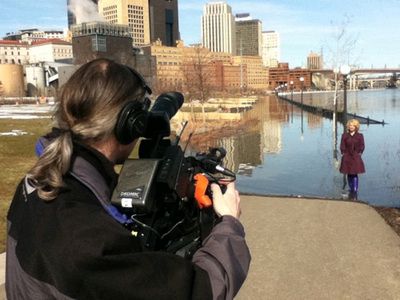Pick a park, vulnerability and joy, reporters standing in water, are WWII aircraft leaving Minnesota, and March sadness.
1) PICK A PARK
Proposed cuts to child protection didn’t get too many Minnesotans worked up in this legislative session, a possible curtailing of Meals on Wheels for seniors hasn’t caused much of a public outcry, the effort to end of programs to keep some elderly people out of nursing homes went largely unnoticed, few seem particularly worried about reducing help for the disabled, and even the rolling back of higher education in the state hasn’t generated a lot of heat outside of the occasional student protest.
But Minnesota state parks? This, judging by the front pages and Web sites, might be the one that provides the public-opinion referendum on how the Legislature is doing. If memory serves, nobody running for office last summer had a stump speech with the applause line, “elect me and I’ll make sure you can’t go camping!” But what if they had?
A 25% whack from the proposed natural resources budget could lead to the closing of 10 state parks, according to DNR officials after yesterday’s passage of funding bills in the Minnesota House and Senate. Which ones, they didn’t say. Republicans say the DNR is using scare tactics.
Let’s assume the plan will close 10. Which 10? You decide. Here are the state parks (click image for larger image):
Unless the DNR tries to make the cuts obvious, we can assume Split Rock Lighthouse, Fort Snelling and Gooseberry Falls are safe; they’re iconic. Pick 10 we can live without.
How many times a year do you visit a Minnesota state park?online survey
2) ON VULNERABILITY AND JOY
Let’s recalibrate for a moment. I’ll bet Jennifer Haugh, a former colleague (she was the MPR spokesperson), speaks for thousands of people in describing what it was like to lose a job and embark on a new life. Yesterday, she spoke at morning prayers at Harvard, on the authenticity of being vulnerable, and the source of joy. You’d never guess she’s a native Minnesotan.
3) REPORTERS STANDING IN WATER
Today’s submission: (h/t: David Gillette)
Patrick Steele reminds us of this oldie but goodie:
On the flood front, the Mississippi River in St. Paul is cresting over the next few hours. So is the Minnesota River at Savage (it’s dropping at Jordan). In Fargo, some residents are upset because there’s an evacuation plan for moving residents if the Red River flooding gets too serious, but officials won’t say what it is.
That’s led to an editorial today in the Fargo Forum:
The handling of this year’s evacuation plan has been clumsy, to say the least. Early media requests to see the document were met with the claim that there was no plan. But then, miraculously, there was a plan. But it was confidential. The 2011 plan apparently details how an evacuation would be undertaken – including travel routes, staging locations and responsibility for executing the plan’s components.
In other words, the document that did not exist and then did is composed of exactly the kind of information residents would need if the flood is severe enough to warrant evacuation. It makes no sense to classify information that would be vital to residents who might want to develop family or individual evacuation plans to dovetail with the city’s procedures.
4) MOVING ON FROM WWII
Times are a changing when “Moonlight Serenade” makes the neighbors complain. The Pioneer Press reports the days of a World War II collection 0f airplanes at Fleming Field in South St. Paul could be numbered. A couple times a year, the Commemorative Air Force holds ’40s-themed dances in its large hangar on the field. But the city says the lack of sprinklers puts an end to that, even though the huge hangar is wide open during the dances.
And the airport manager says some neighbors complain about the noise anyway.
Here’s an extensive piece on the place from colleague Julia Schrenkler, posted here last summer.
5) MARCH SADNESS
Sometimes you have to take a stand– or seat — for what you believe in. In Delaware, a neighborhood believes in having basketball hoops.
VIRAL VIDEO OF THE DAY
A sad reminder that the most dangerous and vicious animal in the world, is often a teenage human.
TODAY’S QUESTION
Twin Cities home prices fell 3.4 percent from December to January. The decline was the worst reported among 20 major metropolitan areas. What would you be doing differently if the housing market were better?
WHAT WE’RE DOING
Midmorning (9-11 a.m.) – First hour: The savings and hardship of Medicare reform.
Second hour: Abu Ghraib prison photos depicted the the embarrassing treatment of suspected terrorists who were alive. Now, gruesome images of dead civilians, some pictured as prized mementos, are another tarnish for the U.S. military. Hear how photos of The Kill Team made their way to Rolling Stone magazine.
Midday (11 a.m. – 1 p.m.) – First hour: Former State Department and USAID official Brian Atwood discusses the Obama Doctrine and U.S. influence in the world.
Second hour: Rebroadcast of a conversation between 1984 presidential candidate Walter Mondale and his running mate Geraldine Ferraro, in an event moderated by former Minnesota secretary of state Joan Growe
Talk of the Nation (1-3 p.m.) – First hour: Weekly politics talk.
Second hour: The Palestinian standoff.
All Things Considered (3-6:30 p.m.) – – In an impoverished patch of south Minneapolis, where the nation’s largest Somali community abuts one of the most dense urban concentrations of Native Americans, efforts are under way to smooth over frictions between the two communities. A friendship circle of Somali and American Indians started about a year ago when a Native woman was attacked by a Somali youth. Tensions were further inflamed last winter when a Native pedestrian was struck and killed by a Somali driver. At monthly meetings, individuals from the two ethnic groups confess to their own stereotypes and plot ways to bring the communities together. MPR’s Laura Yuen will have the story.
Lac qui Parle is the healthiest county in Minnesota, while Cass County is the least healthy according to new study. In fact, most of the least-healthy counties in Minnesota are in the north, while the healthiest are in the southern counties. MPR’s Lorna Benson will explain why.
Damage from Japan’s natural disasters and nuclear crisis is expected to cost the country hundreds of billions of dollars. Even before the disaster the country was deeply in debt. So what are the prospects for an economic comeback in Japan? NPR will report.



